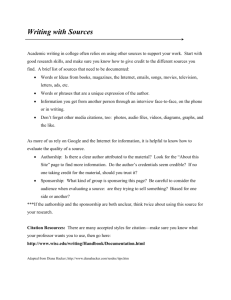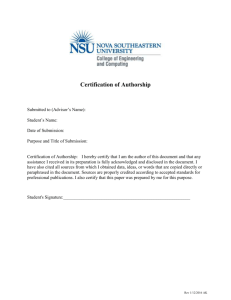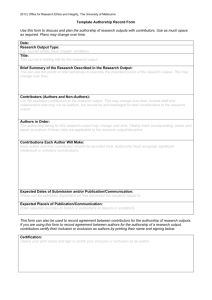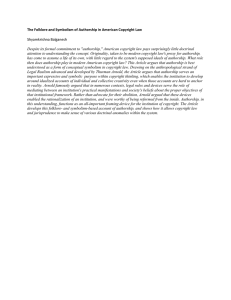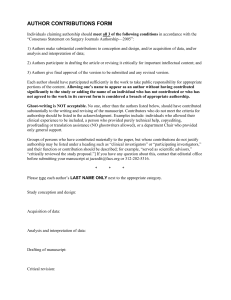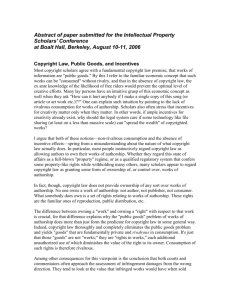HST 502 - Survival Skills for Researchers Spring 2003
advertisement
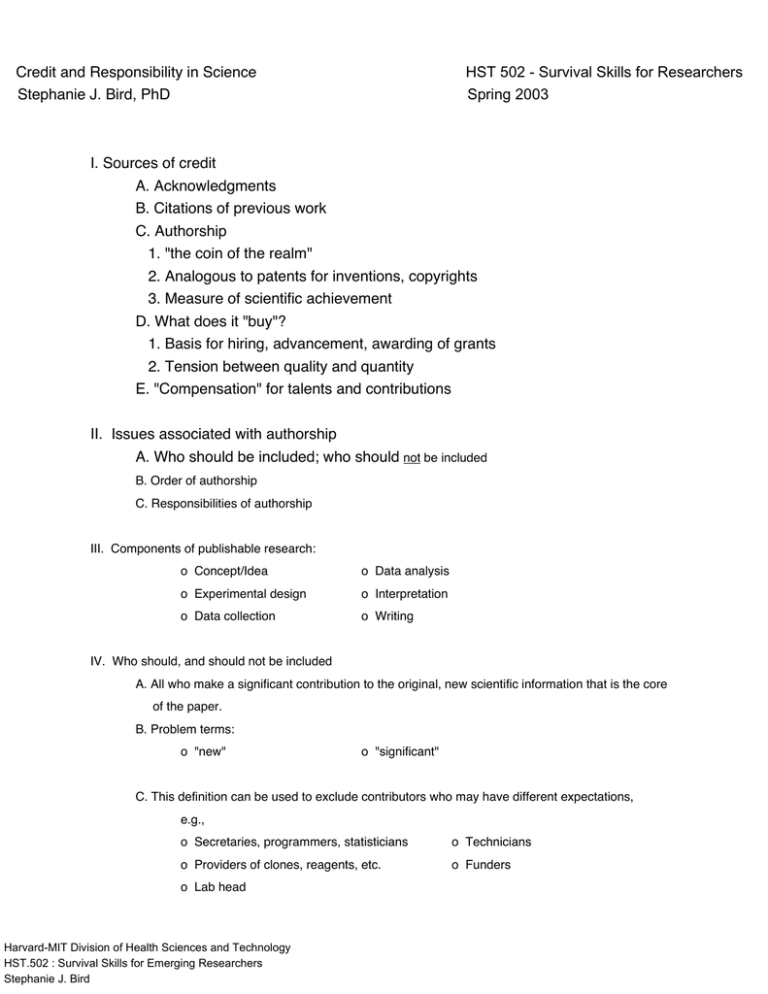
HST 502 - Survival Skills for Researchers Spring 2003 Credit and Responsibility in Science Stephanie J. Bird, PhD I. Sources of credit A. Acknowledgments B. Citations of previous work C. Authorship 1. "the coin of the realm" 2. Analogous to patents for inventions, copyrights 3. Measure of scientific achievement D. What does it "buy"? 1. Basis for hiring, advancement, awarding of grants 2. Tension between quality and quantity E. "Compensation" for talents and contributions II. Issues associated with authorship A. Who should be included; who should not be included B. Order of authorship C. Responsibilities of authorship III. Components of publishable research: o Concept/Idea o Data analysis o Experimental design o Interpretation o Data collection o Writing IV. Who should, and should not be included A. All who make a significant contribution to the original, new scientific information that is the core of the paper. B. Problem terms: o "new" o "significant" C. This definition can be used to exclude contributors who may have different expectations, e.g., o Secretaries, programmers, statisticians o Technicians o Providers of clones, reagents, etc. o Funders o Lab head Harvard-MIT Division of Health Sciences and Technology HST.502 : Survival Skills for Emerging Researchers Stephanie J. Bird D. Hourly wages, academic credit, commissions are irrelevant in assessing credit. V. Council of Biology Editors (CBE): Every author must be able to take public responsibility for the contents, i.e., rationale for research, and how observations were made, and how conclusions follow from the data. Revised to: "contributions to (a) conception and design, or analysis and interpretation of data; and to (b) drafting the article or revising it critically for important intellectual content; and on (c) final approval of the version to be published. (Intl. Comm. of Med. Journal Eds, 1997) VI. Contributor-Guarantor model A. Contributors do not have the responsibilities of authorship B. Guarantor is equivalent to current notions of author C. This model has advantages and disadvantages. VII. Order of authorship A. No definite rules 1. Reflect extent or nature of contribution a. "most" work b. central experiments c. idea d. author of 1st draft 2. Senior scientist - formerly first, now first or last 3. Alphabetical - in experimental physical sciences; required by some journals; in some labs. 4. Rotating 5. Usually decided by lab head and/or first author. 6. Authorship re review articles is even less well defined. B. Why order matters 1. Reference style, i.e., 1st author et al. 2. Assumptions of reader C. Does order really matter? - Matthew effect D. Discuss criteria and resolve with lab head and colleagues early 1. Clarify personal conventions, policy, expectations 2. Can be easier said than done VIII. Responsibility of authorship A. Review the manuscript in order 1. To refine it 2. To correct it 3. To be able to take public responsibility for it B. Corresponding right to assure and maintain one's professional reputation. C. CBE also states that authors are expected to be able to assure that: 1. Standards of ethical conduct of research have been adhered to, e.g., re: human subjects, animals, precautions regarding release of genetically engineered organisms 2. The paper adequately ties work presented to previous work whether it substantiates or contradicts the work presented. 3. The paper includes only and all observations actually made. D. Collaborations are often a difficult area 1. Differences in expertise are the basis for collaboration but limit understanding 2. Trust is not enough 3. Responsibility to students, postdocs, etc. Selected Bibliography HST 502 Spring 2001 AUTHORSHIP - CREDIT AND RESPONSIBILITY CBE Style Manual Committee (1983) Ethical conduct in authorship and publication. In CBE Style Manual, 5th edition. Council of Biological Education, Bethesda, MD, pp. 1-6. Croll, Roger P. (1984) The noncontributing author: An issue of credit and responsibility. Perspectives in Biology and Medicine 27 (3): 401-407. Jones, A.H. and McLellan,F., eds. (2000) Ethical Issues in Biomedical Publication, Johns Hopkins Univ. Press, Baltimore. International Committee of Medical Journal Editors (1997) Uniform requirements for manuscripts submitted to biomedical journals. New Engl J. Med 335: 309-315. LaFollette, Marcel C. (1992) Stealing into Print: Fraud Plagiarism, and Misconduct in Scientific Publishing. Univ. of California Press, Berkeley and Los Angeles. Merton, Robert K. (1968) The Matthew effect in science. Science 159: 56-63. Rennie, Drummond, Yank, V. and Emanuel, Linda (1997) When authorship fails: A proposal to make contributors accountable. J Amer. Med. Assoc. 278: 579-585.
